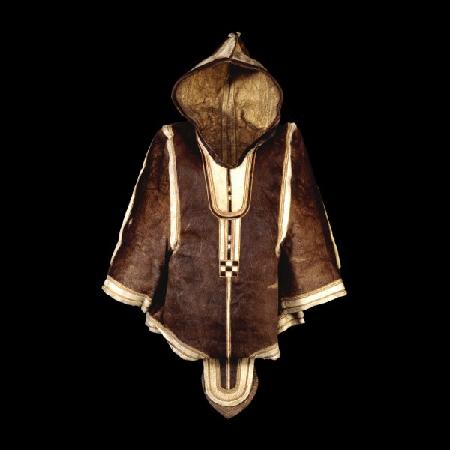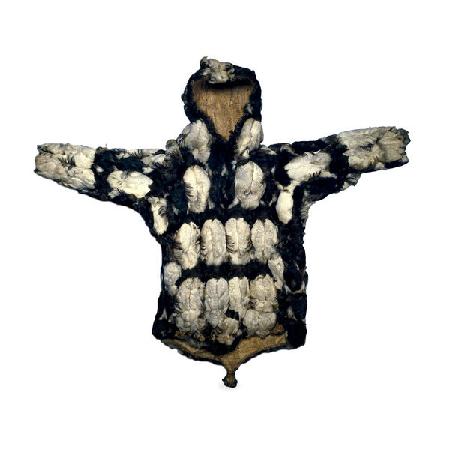|
|
Canku Ota |
|
|
(Many Paths) |
||
|
An Online Newsletter Celebrating Native America |
||
|
January 26, 2002 - Issue 54 |
||
|
|
||
|
Annuraaq: Clothing of Arctic North America |
||
|
|
||
|
Photo 1: Girl's
caribou-skin parka, Inuit, early 19th century AD, From West Greenland,
North America Photo 2: Birdskin parka, Inughuit, late 19th century AD,
Collected in the Smith Sound area, northern Greenland
The British Museum, Department of Ethnography |
|
From February 15-May 27, a new BP Ethnography Showcase Annuraaq: Arctic Clothing from Igloolik will be featured in the Central Saloon (36), focusing on contemporary work of women from Igloolik. The exhibition is organised in consultation with the Inullariit Elders' Society, Igloolik, the Igloolik Research Centre of the Nunavut Research Institute, and the Department of Culture, Language, Elders, and Youth of the Government of Nunavut. This exhibition will be accompanied by a COMPASS online tour. March 29-31 are the dates for the conference on Arctic Clothing of North America - Alaska, Canada, Greenland, to be held at the British Museum in the Clore Centre of the new Queen Elizabeth II Great Court. 25 speakers from USA, Canada, Greenland, and Europe, including Native seamstresses, anthropologists, designers and Arctic explorers, are expected. This event is sponsored by the Eugene V and Clare E Thaw Charitable Trust, Santa Fe, through the American Friends of the British Museum, with additional assistance from the Office of the Government of Québec, the Society of Canadian Friends of the British Museum, and from the Sosland Foundation, Kansas City. Both projects are associated with the Clothworkers' Centre for World Textiles, presently planned to open in 2003 as part of the new British Museum Study Centre. The English word anorak comes from annuraaq, meaning "a piece of clothing" in the language of the Inuit of the Canadian Arctic. Like other forms of Inuit technology, Inuit clothing fascinates by its apparently simple design and great effectiveness. For instance, traditional Inuit clothing is designed to capture air warmed by the body. In winter, when hunting or traveling, two layers of clothing are worn. Warm air is thus trapped between the two layers of clothing and the body, providing highly effective insulation against the cold.
This exhibition focuses on the clothing made by the people of Igloolik, an Inuit community of about 1300 people some 200 miles north of the Arctic Circle. It explores the whole process of making and using clothing. Much of the information in the exhibition was recorded from Inuit elders by the Nunavut Research Institute's Igloolik Research Centre, and the Inullariit Elders' Society, Igloolik. The display will include both contemporary and historic clothing and tools from across the Canadian Arctic, some of which were collected by William E. Parry in the 1820s during his search for the Northwest Passage, as well as comparative examples from Alaska and Greenland.
|
|
|
||
|
|
||
| Canku Ota is a free Newsletter celebrating Native America, its traditions and accomplishments . We do not provide subscriber or visitor names to anyone. Some articles presented in Canku Ota may contain copyright material. We have received appropriate permissions for republishing any articles. Material appearing here is distributed without profit or monetary gain to those who have expressed an interest. This is in accordance with Title 17 U.S.C. section 107. | ||
|
Canku Ota is a copyright © 2000, 2001, 2002 of Vicki Lockard and Paul Barry. |
||
|
|
|
|
|
The "Canku Ota - A Newsletter Celebrating Native America" web site and its design is the |
||
|
Copyright © 1999, 2000, 2001, 2002 of Paul C. Barry. |
||
|
All Rights Reserved. |
||

 In
early 2002, the Department of Ethnography,
The British Museum, is organising two events which arise out of a long
association and collaboration with the community of Igloolik in Nunavut,
Canada:
In
early 2002, the Department of Ethnography,
The British Museum, is organising two events which arise out of a long
association and collaboration with the community of Igloolik in Nunavut,
Canada: Although
the Inuit's way of life has changed significantly over the last decades,
traditional skin clothing remains important to Inuit. Not only are certain
kinds of traditional style clothing still preferred over fabric-made
garments, but the making and use of clothing plays a significant role
in keeping alive Inuit cultural values and knowledge. Clothing both
sustains and expresses Inuit identity.
Although
the Inuit's way of life has changed significantly over the last decades,
traditional skin clothing remains important to Inuit. Not only are certain
kinds of traditional style clothing still preferred over fabric-made
garments, but the making and use of clothing plays a significant role
in keeping alive Inuit cultural values and knowledge. Clothing both
sustains and expresses Inuit identity.